Native
Eulia ministrana (Linnaeus) (Tortricidae: Tortricinae: Cochylini)
Common names: ferruginous Eulia moth, brassy twist, brassy tortrix
Synonyms: dilutana (Lophoderus ministrana ab.), ferrugana (Olethreutes), ferugana (Tortrix), infuscanus (Lophoderus ministrana ab.), livoniana (Ptycholoma), subfascianus (Lophoderus), subfascianus (Lophoderus)
FWL: 9.5-11.5 mm
Head, thorax orange to dark red; thorax with strong thoracic tuft; forewing broad, orange-red to dark red; pale yellow or white patches present along costacosta:
the anterior margin of each wing  ; fasciaefasciae:
; fasciaefasciae:
plural of "fascia" faint, diffuse, often obsolete; male with forewing costal absent; hindwing pale gray to dark gray.
faint, diffuse, often obsolete; male with forewing costal absent; hindwing pale gray to dark gray.
Male genitalia are characterized by a very slender uncusuncus:
a sclerotized process which is fused to the posterodorsal margin of tergum IX ; broadly quadrate terminal plate of the gnathosgnathos:
; broadly quadrate terminal plate of the gnathosgnathos:
a narrow bandlike structure that joins the posterolateral edges of the tegumen and supports the anal tube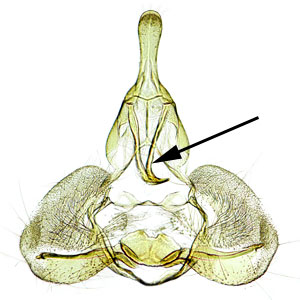 ; elongate, elliptical valvaevalvae:
; elongate, elliptical valvaevalvae:
plural of "valva" ; and an extremely slender, hooked phallusphallus:
; and an extremely slender, hooked phallusphallus:
the male intromittent organ (penis); see "aedeagus" 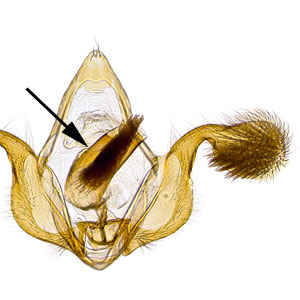 . Female genitalia are characterized by broad papillae analespapillae anales:
. Female genitalia are characterized by broad papillae analespapillae anales:
the female ovipositor lobes 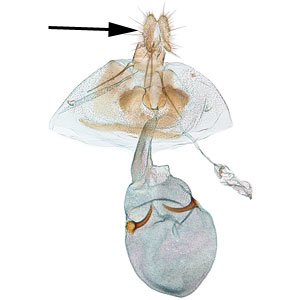 ; a large, well-sclerotized sterigmasterigma:
; a large, well-sclerotized sterigmasterigma:
the sclerotized region surrounding the female ostium bursae  ; a corpus bursaecorpus bursae:
; a corpus bursaecorpus bursae:
a dilated membranous sac at the anterior end of the bursa copulatrix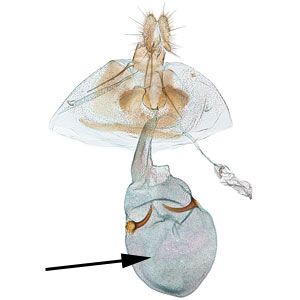 poorly differentiated from ductus bursaeductus bursae:
poorly differentiated from ductus bursaeductus bursae:
a membranous tube connecting the ostium bursae to the corpus bursae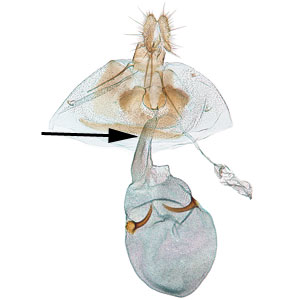 , densely covered with minute sclerites anteriorly.
, densely covered with minute sclerites anteriorly.
The following account is summarized from Kuznetzov (1978)Kuznetzov (1978):
Kuznetzov, V. I. 1978. Family Tortricidae (Olethreutidae, Cochylidae), pp. 193-680. In : Medvedev, G. S. (ed.), Keys to the insects of the European part of the USSR 4(1). Opred. Faune SSSR (117): 193-686 [In Russian; English version published for the National Science Foundation (Washington, DC) by Amerind Publishing Co.].. Detailed accounts of larval chaetotaxychaetotaxy:
the arrangement of setae (in reference to Lepidoptera larvae), often depicted on a "setal map"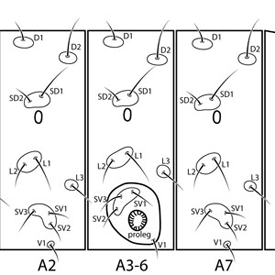 have not been published.
have not been published.
Young larvae are yellowish-green with black heads. Mature larvae have the head dark amber brown; prothoracic shieldprothoracic shield:
a sclerotized plate on the dorsal surface of the prothorax 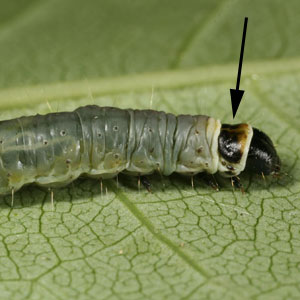 , body, and legs pale green.
, body, and legs pale green.
Eulia ministrana is unlikely to be confused with any other species of tortricid. It is a highly distinctive species in both forewing pattern and genitalia.
Despite its widespread occurrence, very little is published in the way of life history notes for Eulia ministrana. There is a single generation per year, with adults peaking in activity in mid-June, regardless of hemisphere. In North America, adults fly as early as late May in Washington and Alaska and as late as mid-July in Nova Scotia and New Brunswick. Females lay eggs single or in groups of up to 20 on the leaves the host plant. Larvae feed inside rolled leaves. Overwintering occurs as a mature larva with pupation occurring in the spring (Kuznetzov 1978Kuznetzov 1978:
Kuznetzov, V. I. 1978. Family Tortricidae (Olethreutidae, Cochylidae), pp. 193-680. In : Medvedev, G. S. (ed.), Keys to the insects of the European part of the USSR 4(1). Opred. Faune SSSR (117): 193-686 [In Russian; English version published for the National Science Foundation (Washington, DC) by Amerind Publishing Co.].; Zrerev & Kozlov 2020).
Eulia ministrana is a highly polyphagous species and has been recorded feeding on many different plants.
| Host plant | Host plant family | Reference(s) | ||
| Alnus glutinosa | Betulaceae | Bradley et al. 1973Bradley et al. 1973: Bradley, J. D., Tremewan, W. G., Smith, A. 1973. British Tortricoid Moths, Cochylidae and Tortricidae: Tortricinae. The Ray Society, London. 251 pp.; Jaros & Spitzer 2002 |
||
| Alnus rubra | Betulaceae | Prentice 1966Prentice 1966: Prentice, R. M. 1966. Vol. 4. Microlepidoptera. In : Forest Lepidoptera of Canada recorded by the Forest Insect Survey. Dept. For. Canada Publ. 1142: 543-840.; Brown & Passoa 1998 |
||
| Alnus sp. | Betulaceae | Ferguson 1975Ferguson 1975: Ferguson, D. C. 1975. Host records for Lepidoptera reared in eastern North America. United States Department of Agriculture Technical Bulletin 1521. 49 pp.; Brown & Passoa 1998 |
||
| Betula sp. | Betulaceae | Meyrick MS 1938Meyrick MS 1938: Meyrick MS 1938. Unpublished manuscript by E. Meyrick at BMNH, data captured by Gaeden Robinson.; Prentice 1966Prentice 1966: Prentice, R. M. 1966. Vol. 4. Microlepidoptera. In : Forest Lepidoptera of Canada recorded by the Forest Insect Survey. Dept. For. Canada Publ. 1142: 543-840.; Bradley et al. 1973Bradley et al. 1973: Bradley, J. D., Tremewan, W. G., Smith, A. 1973. British Tortricoid Moths, Cochylidae and Tortricidae: Tortricinae. The Ray Society, London. 251 pp.; Brown & Passoa 1998 |
||
| Corylus avellana | Betulaceae | Bradley et al. 1973Bradley et al. 1973: Bradley, J. D., Tremewan, W. G., Smith, A. 1973. British Tortricoid Moths, Cochylidae and Tortricidae: Tortricinae. The Ray Society, London. 251 pp. |
||
| Corylus sp. | Betulaceae | LACM IndexLACM Index: LACM Index. Records from the card file at the Los Angeles County Museum of Natural History, Los Angeles, California; transcribed by Gaeden Robinson (BMNH).; Meyrick MS 1938Meyrick MS 1938: Meyrick MS 1938. Unpublished manuscript by E. Meyrick at BMNH, data captured by Gaeden Robinson.; Brown & Passoa 1998 |
||
| Viburnum sp. | Caprifoliaceae | Ferguson 1975Ferguson 1975: Ferguson, D. C. 1975. Host records for Lepidoptera reared in eastern North America. United States Department of Agriculture Technical Bulletin 1521. 49 pp.; Brown & Passoa 1998 |
||
| Vaccinium myrtillus | Ericaceae | Bradley et al. 1973Bradley et al. 1973: Bradley, J. D., Tremewan, W. G., Smith, A. 1973. British Tortricoid Moths, Cochylidae and Tortricidae: Tortricinae. The Ray Society, London. 251 pp.; Emmet 1992Emmet 1992: Emmet, A.M. 1992. Life history and habits of the British Lepidoptera. Pp. 61-300. In : Emmet, A.M., Heath, J. (eds.), The Moths and Butterflies of Great Britain and Ireland, 7. 400 pp., Harley Books, Colchester.; Brown & Passoa 1998 |
||
| Fagus sp. | Fagaceae | Bradley et al. 1973Bradley et al. 1973: Bradley, J. D., Tremewan, W. G., Smith, A. 1973. British Tortricoid Moths, Cochylidae and Tortricidae: Tortricinae. The Ray Society, London. 251 pp.; Brown & Passoa 1998 |
||
| Fagus sylvatica | Fagaceae | Bradley et al. 1973Bradley et al. 1973: Bradley, J. D., Tremewan, W. G., Smith, A. 1973. British Tortricoid Moths, Cochylidae and Tortricidae: Tortricinae. The Ray Society, London. 251 pp. |
||
| Quercus sp. | Fagaceae | Bradley et al. 1973Bradley et al. 1973: Bradley, J. D., Tremewan, W. G., Smith, A. 1973. British Tortricoid Moths, Cochylidae and Tortricidae: Tortricinae. The Ray Society, London. 251 pp. |
||
| Fraxinus excelsior | Oleaceae | Bradley et al. 1973Bradley et al. 1973: Bradley, J. D., Tremewan, W. G., Smith, A. 1973. British Tortricoid Moths, Cochylidae and Tortricidae: Tortricinae. The Ray Society, London. 251 pp. |
||
| Epilobium sp. | Onagraceae | Bradley et al. 1973Bradley et al. 1973: Bradley, J. D., Tremewan, W. G., Smith, A. 1973. British Tortricoid Moths, Cochylidae and Tortricidae: Tortricinae. The Ray Society, London. 251 pp.; Brown & Passoa 1998 |
||
| Frangula alnus | Rhamnaceae | Jaros & Spitzer 2002 | ||
| Rhamnus cathartica | Rhamnaceae | Bradley et al. 1973Bradley et al. 1973: Bradley, J. D., Tremewan, W. G., Smith, A. 1973. British Tortricoid Moths, Cochylidae and Tortricidae: Tortricinae. The Ray Society, London. 251 pp. |
||
| Rhamnus sp. | Rhamnaceae | Bradley et al. 1973Bradley et al. 1973: Bradley, J. D., Tremewan, W. G., Smith, A. 1973. British Tortricoid Moths, Cochylidae and Tortricidae: Tortricinae. The Ray Society, London. 251 pp. |
||
| Prunus avium | Rosaceae | Ferguson 1975Ferguson 1975: Ferguson, D. C. 1975. Host records for Lepidoptera reared in eastern North America. United States Department of Agriculture Technical Bulletin 1521. 49 pp.; Brown & Passoa 1998 |
||
| Prunus sp. | Rosaceae | Bradley et al. 1973Bradley et al. 1973: Bradley, J. D., Tremewan, W. G., Smith, A. 1973. British Tortricoid Moths, Cochylidae and Tortricidae: Tortricinae. The Ray Society, London. 251 pp.; Ferguson 1975Ferguson 1975: Ferguson, D. C. 1975. Host records for Lepidoptera reared in eastern North America. United States Department of Agriculture Technical Bulletin 1521. 49 pp.; Brown & Passoa 1998 |
||
| Rosa sp. | Rosaceae | Bradley et al. 1973Bradley et al. 1973: Bradley, J. D., Tremewan, W. G., Smith, A. 1973. British Tortricoid Moths, Cochylidae and Tortricidae: Tortricinae. The Ray Society, London. 251 pp. |
||
| Rubus chamaemorus | Rosaceae | Bradley et al. 1973Bradley et al. 1973: Bradley, J. D., Tremewan, W. G., Smith, A. 1973. British Tortricoid Moths, Cochylidae and Tortricidae: Tortricinae. The Ray Society, London. 251 pp. |
||
| Host plant table (embedded)
View full screen host table here DistributionEulia ministrana is broadly Holarctic in distribution, ranging from Great Britain across northern Eurasia as far east as Siberia and Japan. In North America, it has been recorded from Alaska to Oregon and east to Maine and Nova Scotia and south through the Appalachians to Tennessee and North Carolina. There is no clear genetic separation between Palearctic and Nearctic populations (Gilligan et al. 2020bGilligan et al. 2020b: LinksAdditional photos and a distribution map of this species in North America are available at Moth Photographers Group. |